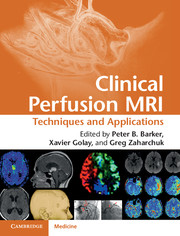Book contents
- Frontmatter
- Contents
- List of Contributors
- Foreword
- Preface
- List of Abbreviations
- Section 1 Techniques
- 1 Imaging of flow: basic principles
- 2 Dynamic susceptibility contrast MRI: acquisition and analysis techniques
- 3 Arterial spin labeling-MRI: acquisition and analysis techniques
- 4 DCE-MRI: acquisition and analysis techniques
- 5 Imaging of brain oxygenation
- 6 Vascular space occupancy (VASO) imaging of cerebral blood volume
- 7 MR perfusion imaging in neuroscience
- Section 2 Clinical applications
- Index
- References
3 - Arterial spin labeling-MRI: acquisition and analysis techniques
from Section 1 - Techniques
Published online by Cambridge University Press: 05 May 2013
- Frontmatter
- Contents
- List of Contributors
- Foreword
- Preface
- List of Abbreviations
- Section 1 Techniques
- 1 Imaging of flow: basic principles
- 2 Dynamic susceptibility contrast MRI: acquisition and analysis techniques
- 3 Arterial spin labeling-MRI: acquisition and analysis techniques
- 4 DCE-MRI: acquisition and analysis techniques
- 5 Imaging of brain oxygenation
- 6 Vascular space occupancy (VASO) imaging of cerebral blood volume
- 7 MR perfusion imaging in neuroscience
- Section 2 Clinical applications
- Index
- References
Summary
Introduction
Among the various existing MRI methods for measuring cerebral blood flow (CBF), arterial spin labeling (ASL) occupies a special position, as much for its plethora of different techniques and MRI sequences, as for the fact that each of these methods is completely non-invasive, and therefore does not require injection of any exogenous contrast agent or tracer. Indeed, as suggested in the name of the technique, the measurement of perfusion is obtained by non-invasive labeling of arterial blood water spins (i.e., inversion or saturation) proximal to the tissue of interest. These labeled spins are then imaged at a later time point after exchange with the tissue magnetization [1]. As such, ASL can be repeated over a time period of a few seconds or minutes, and has a wide range of applications in the brain, from basic neuroscience to applied clinical neurology, as well as for the assessment of organ homeostasis anywhere in the body. A comprehensive description of the applications of ASL is given in later chapters of this book; this chapter will focus on the technique itself. While applications of ASL in the body are still an emerging topic, its application in neurology and neuroscience is now well established, and most of this introductory chapter will therefore refer to the brain, unless otherwise stated [2].
- Type
- Chapter
- Information
- Clinical Perfusion MRITechniques and Applications, pp. 38 - 57Publisher: Cambridge University PressPrint publication year: 2013
References
- 3
- Cited by



